
|

|
Forum Index : Other Stuff : Building a hydraulic ram
| Page 1 of 2 |
|||||
| Author | Message | ||||
| Gizmo Admin Group Joined: 05/06/2004 Location: AustraliaPosts: 5078 |
This is one of those little projects I've wanted to do for many years, but until now I didn't have the natural resource needed, a flowing stream. My little creek has a pretty consistant flow of about, at a guess, 1 litre per second or two. Not a lot of drop, about 2 meters across the entire length of 200 meters. Most of the drop, about 1.2 meters, is over a distance of 25 meters and this is where I installed the ram. I built the ram using these free plans as a guide, its a design that uses common hardware parts and can be put together in a few minutes. As this was a test build, I substituted the pressure chamber with a plastic coke bottle. 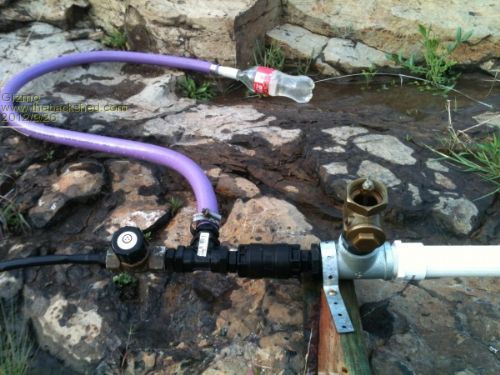
The inlet pipe and standing tube are 40mm light PVC, and the drive pipe is 40mm heavy wall PVC. This pic shows the general layout, sorry its not a good picture. 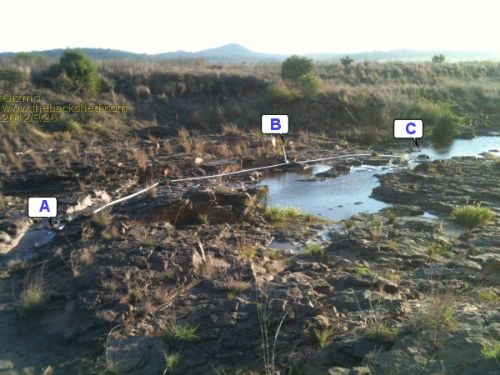
A is the inlet, B is the standing pipe, and C is the ram. The drive pipe, between B and C is 9 meters long. Outlet was about 7 meters above the ram when this picture was taken, but its now pumping water all the way to a tank on a mound behind my shed, a lift of 10 to 15 meters at a guess. 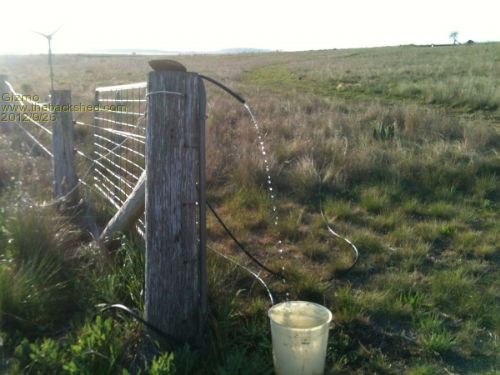
I have to say, I'm pretty impressed with these rams, and had a lot of fun experimenting and learning how they work. My pump has about 1.2 meters of head, and is pumping water to a tank thats 200 meters away and over 10 meters above the creek. The tank has depth markings so I can tell how much water is been fed into it, about 50 liters per hour. Its a 500 liter tank so will be overflowing by the morning, and I can expect 1000 liters each day, which will be used to water the yard and plants. These are some of the tips I picked up building my pump. Hydraulic rams like back pressure. In fact, this design wont work without it. Any sudden changes in back pressure can put the pump out of rhythm and it will probably stop, so its best to have the outlet drippling into a tank and leave it alone. There is a lot of vibration in the pump, and mine fell apart a few times until I had secured it with lots of large rocks. The inlet pipe and drive pipe need to be downhill all the way, any rises will fill with air and restrict flow. A stand pipe helped purge any air bubbles sucked into the inlet pipe and improved the performance of my pump. If the pump stops over night, blueclaw yabbies will move in and call it home, then get mangled in the clapper when you restart it. Next I'll build a proper pressure chamber and find a way to secure the ram to the rocks before the next heavy rain. I'm only using a tiny portion of the creeks flow, so I could build a much larger pump, but maybe later. This has been fun. If your interested in hydraulic rams, youtube is a great place to start, lots of ram videos. Glenn 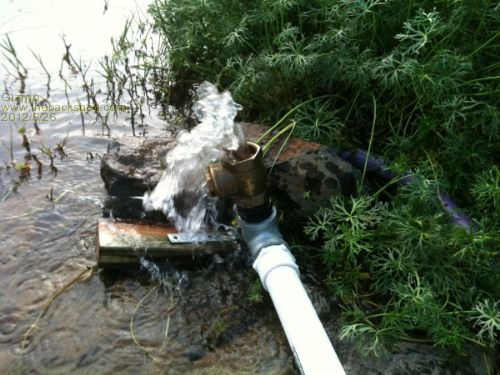
The best time to plant a tree was twenty years ago, the second best time is right now. JAQ |
||||
fillm Guru Joined: 10/02/2007 Location: AustraliaPosts: 730 |
Well Done Glenn...   . would you get more flow out of a 2 litre coke bottle . would you get more flow out of a 2 litre coke bottle  PhillM ...Oz Wind Engineering..Wind Turbine Kits 500W - 5000W ~ F&P Dual Kits ~ GOE222Blades- Voltage Control Parts ------- Tower kits |
||||
| yahoo2 Guru Joined: 05/04/2011 Location: AustraliaPosts: 1166 |
Great to see some proper country technology in action. I can think of a couple of tweaks you might consider if this is going to be a permanent fixture. Definitely need a barrel union in the inlet pipe just after a gate valve at the pump, this means it is a 2 minute job to rip the pump out and chuck it on the bench to repair or clean it. switch to more flexible poly pipe upstream of the stand-pipe this gives you the option of repositioning the inlet easily or adding floats and using wires to the bank to hold it. Buy or build a foot-valve strainer for the suction inlet. I find slotted holes are the best and removable so that algae can be scrubbed off the inside . Pressure accumulators without bladders are a pain, they constantly fill up with water and need draining. There are perfectly good household pump pressure tanks thrown away when a new pump is installed, might be worth a scrounge around. edit: I have to say I am genuinely surprised it is working with the spring-loaded poly non return valve. I'm confused, no wait... maybe I'm not... |
||||
| Gizmo Admin Group Joined: 05/06/2004 Location: AustraliaPosts: 5078 |
Thanks for the tips Yahoo. Last night the pump stopped before filling the tank, just. About an inch from the top, so it pumped 500 liters overnight. The reason it stopped was the 600ml coke bottle developed a little hole where it was sitting on the rocks, the vibration must have worn down the plastic. So I fitted a 1.25 litre bottle ( working up to a 2 litre Phill  ), and its mounted on the pump so it sits upright. Back in action. ), and its mounted on the pump so it sits upright. Back in action.
Yeah the water filling the pressure tank is a problem. One tip I've heard of is filling the pressute tank with a slightly inflated bike tube. Eventually I'll move the pump further down the creek to gain the full head. This will give about 2 meters, the extra 600mm odd will give a fair bit more flow at the water tank. But I'll need about 150 meters of 2 inch poly pipe for the inlet pipe. Glenn The best time to plant a tree was twenty years ago, the second best time is right now. JAQ |
||||
| vasi Guru Joined: 23/03/2007 Location: RomaniaPosts: 1697 |
For outsiders like me, blueclaw yabbies: Source here Great project! Can be used (or, is what I would like to have) to irrigate the garden using perforated pipes for drip water... (drip irrigation) Hobbit name: Togo Toadfoot of Frogmorton Elvish name: Mablung Miriel Beyound Arduino Lang |
||||
| Gizmo Admin Group Joined: 05/06/2004 Location: AustraliaPosts: 5078 |
Made some improvements to the ram. Chipped away at a natural fault line in the creek bed to make a little inlet pond thats separate from the main creek flow. Concreted in a dam with a length of 50mm PVC pipe at the bottom. The 40mm pvc fits up this, and fitted a slotted strainer, the slots are facing down so it cant suck air. This gave an extra 200mm of head. Next I bought a 50m length of 1.5inch poly pipe, and moved the ram below the next natural dam, gaining a further 400mm head approx. So now it has about 1.8m of head, but a very long feed pipe. At first I ran the poly pipe along the bank, where it followed the high and low points. Even though these high points were below the level of the pipe entry, they still had air pockets large enough to restrict the flow to little more than a trickle. So I ended up dropping the poly pipe into the creek, where it sat reasonably level, except for a rise at the beginning where it was fed from the inlet pond, and a rise the end towards the standing pipe. This worked, but its not the ideal solution for me, I would rather the pipe was up on the bank so I dont need to worry about storm water draging the poly pipe down the creek. I was thinking of lifting the poly pipe back onto the bank and drilling a small 1mm holes into the top of the pipe at the high points? This in theory would let the air escape and then bleed water, but I'm not sure. Anyway, the pump is now pumping about twice the water as it was before. Glenn The best time to plant a tree was twenty years ago, the second best time is right now. JAQ |
||||
| Gizmo Admin Group Joined: 05/06/2004 Location: AustraliaPosts: 5078 |
OK, found some info on air in pipes and how it reduces flow. This link is to a rather large PDF that explains the problem in detail. http://www.aplv.org/files/docs/AirInPipesManual.pdf Glenn The best time to plant a tree was twenty years ago, the second best time is right now. JAQ |
||||
Downwind Guru Joined: 09/09/2009 Location: AustraliaPosts: 2333 |
Now that the pipe is primed and the air purged from being in the creek, there is no reason why you cant drag it back onto the bank and all should still work, unless it is likely to suck air in on the entry point. (Looks like you have a beaver problem with bridging you creek  ) )
Drilling holes wont work as it will be likely to induce air into the flow from the vacuum of the falling water (siphon effect) although tees and stand pipes along the pipe will work to vent the air, and the stand pipe allows a head of volume preventing air being sucked back into the flow. But the stand pipe should have a volume capacity equal to, or greater than, the square area if the main pipe to prevent it from sucking air through siphon. This could be a smaller stand pipe with a cut off coke bottle reservoir on the top of the stand pipe. Have you given it a name yet? "Roger" would seem fitting. (Roger Ram Jet) Pete Sometimes it just works |
||||
| Gizmo Admin Group Joined: 05/06/2004 Location: AustraliaPosts: 5078 |
The long pipe became a nuisance. We had heavy rain predicted a couple of weeks ago so I lifted the pipe out of the creek and moved the pump to higher ground for a couple of days. Putting it back in and it took about 30 minutes to get the air out of the system! So I've gone back to the short run. It means less flow, but I can move and replace the pump easily. Here is a video of the working pump, this was taken before I made the little dam. http://www.youtube.com/watch?v=0_sTGNXzKfI&feature=plcp Glenn The best time to plant a tree was twenty years ago, the second best time is right now. JAQ |
||||
| Warpspeed Guru Joined: 09/08/2007 Location: AustraliaPosts: 4406 |
Glenn, if you just leave the lower end of the pipe completely open and just let it drain. Over time the trapped air will gradually be entrained and work it's own way out. This may take a long time (hours/days?), but the velocity will gradually increase and eventually there will be solid and a very fast natural flow without any air. A way to speed this up would be to apply a high volume pump at either end, a bit like starting any siphon. Once there is some flow, air trapped in bubbles will be swept down the pipe, and there will be a sudden rush of flow. It does take a lot of faith and patience, but it will work if you give it a chance. *edit* I have never tried it, or heard of it being tried, but a few drips of detergent very slowly added at the intake could create some wonderful air bubbles in the pipe and assist the air evacuation process ??? Cheers, Tony. |
||||
mac46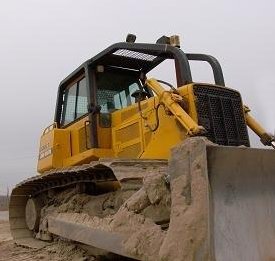 Guru Joined: 07/02/2008 Location: United StatesPosts: 412 |
Hello Glen: Seems like its working well enough as it is...sure beats walking around with buckets in your hands. You might give some thought to installing a larger short joint of pipe close to where the air pocket/pockets are and have a riser there where the air can be sucked out,... any air getting in would gather there. Mac46 I'm just a farmer |
||||
| Greenbelt Guru Joined: 11/01/2009 Location: United StatesPosts: 566 |
Hi Glen, Good to see that Ram in operation. Cheers--------Roe Time has proven that I am blind to the Obvious, some of the above may be True? |
||||
| Barry T Coles Senior Member Joined: 30/07/2009 Location: AustraliaPosts: 109 |
Hi Glenn There is a way around this; if you use micro tube you can put it at the high points & run the other end into the creek, you will have to weigh down the end in the creek to stop it from comming out of the water. What will happen is, as the air builds up at the high points it will be pushed through the micro tube & will bubble out below the water surface in the creek, if you get any suction/venturi effect in the poly you will only draw water back into the poly & not air. Cheers Barry I need to learn from the mistakes of others. I dont have the time to make them all myself. |
||||
Downwind Guru Joined: 09/09/2009 Location: AustraliaPosts: 2333 |
Barry, i disagree, all you will get with the tube below water level in the creek is a pressure lock within the micro tube, and no more than a trapped air bubble. The problem is the creek is lower than the pipe causing a hydrostatic pressure difference in the micro tube, this will have 2 effects. 1- it will create a syphon effect from the pipe to the creek if it is fully primed with water. 2- if it has air trapped, the air pressure needs to exceed the hydrostatic pressure to escape. Think of it as if you put a hose in a barrel of water and you blow in the end, near surface its easy to blow bubbles, as you place the hose deeper in the barrel it gets harder to blow bubbles, this relates to the hydrostatic pressure. Weight of fluid X 0.052 x TVD (true vertical depth in feet) = PSI. For example fresh water weighs 8.34 US pounds per gallon (dont ask me in Kg/m3) 8.34 x 0.052 x 4 (ft depth) = 1.74 psi difference, not a hell of a lot but its a difference in the wrong direction to allow a air bubble to migrate out. If you run the micro tube into a bucket of water at the same level as the pipe then this changes to a pressure difference of 1:1 so the bubble might migrate out. In reality the whole secret is to use physics and the principle of air is lighter than water, and a air bubble will migrate up a column of fluid as long as their is a lower pressure difference for it to move to. Note.. i said migrate up a column and not down a column of fluid. Barry your theory is correct as long as the exit point of the micro tube is equal to or higher than the pipe, but not lower than the pipe. Phew....... that was a long post to sum it up in the last few lines. Pete. Sometimes it just works |
||||
| Warpspeed Guru Joined: 09/08/2007 Location: AustraliaPosts: 4406 |
Think about what happens when you start a siphon going. The air permanently trapped at the high point should always prevent any more than a piddling little bit of flow. What happens in practice is there is an almighty rush, and the entrained air is DRIVEN downwards in the descending pipe. You can very clearly see this happening with a transparent pipe. Likewise in a ram pump, the air will gradually work it's way down the down sloping pipe, although it may take some time to happen if the slope is very gentle. Cheers, Tony. |
||||
Downwind Guru Joined: 09/09/2009 Location: AustraliaPosts: 2333 |
Fair call, but think about what happens when you get a larger bubble in a syphon hose......nothing goes anywhere. A syphon only works while you have fluid falling, introduce air and the negative hydrostatic pressure changes, as the air wants to rise while the fluid wants to fall causing a neutral point. Sometimes it just works |
||||
| Warpspeed Guru Joined: 09/08/2007 Location: AustraliaPosts: 4406 |
True, but as soon as you have SOME flow, the system will purge itself of any remaining air. All I am saying is that with a ram pump that has a very long undulating feed pipe, the initial flow may only be a dribble, but slowly the bubbles will be carried along and downwards with the water flow, and it will self purge. There will always be some initial flow, as long as the pipe entry is the highest point in the whole system. It will then eventually clear itself. You can prove this yourself, by experimenting with a bucket and a few meters of clear plastic pipe, and see it happen. Cheers, Tony. |
||||
| Gizmo Admin Group Joined: 05/06/2004 Location: AustraliaPosts: 5078 |
Not quite. If the flow is slow, the bubbles will rise faster than the water flow, and end up accumulating in the high points, effectively becoming a blockage in the pipe. It gets to a point where flow can be reduced to a near stop. The ram doesn't use a lot of water, which was surprising, so there isn't much water speed in the pipe. I've also noticed the same problem with a hose I'm using to water the yard from the tank. I have a 1/2 inch hose connected to the tank high water outlet, so once the tank is full, the extra water runs down the pipe and onto the lawn. This hose is moved around a couple of times per day. But I found the flow would slow to a drip drip, even though the inlet was under water and the tank started to over flow. Air pockets had formed. The fix was to lift the hose end a few feet and drop it back to the ground, disturbing the air pockets. The water would then gush out with its air bubbles, and flow was restored for a few hours. The best time to plant a tree was twenty years ago, the second best time is right now. JAQ |
||||
| Don B Senior Member Joined: 27/09/2008 Location: AustraliaPosts: 190 |
Hi Glenn, Not sure if I understand the problem completely but, as long as you have positive pressure at the high points, you should be able to set up some temporary bleed points using self tapping screws drilled into your pipe. This should work particularly well if you are using poly pipe, as the screws should be self sealing once screwed back in. I guess that the process would then be very much like bleeding the air out of a diesel fuel system, where you start with the lowest bleed point, and work your way up opening each screw till all that comes out is water. As water will tend to absorb air if the pressure is above atmospheric, once bled, it should hopefully stay that way. Regards Don B |
||||
| Don B Senior Member Joined: 27/09/2008 Location: AustraliaPosts: 190 |
Hi again Glenn, As an afterthought, maybe what you need at the high points is some sort of air release valve. These are commonly used on water pipelines for the very reasons that you list. Basically, they are a float valve that sits at a high point. So long as there is water to lift the float, the valve seals. When air accumulates, the float stops floating and no longer holds the valve closed, so the air is vented until the water level rises and the float again closes the valve. The valve is set above the level of the high point of the pipe so that, once the air is vented, water can flow through the full diameter of the pipe. Not exactly sure how you would contrapt a valve like this, but I would be surprised if Google and similar sites can't suggest something. Regards Don B |
||||
| Page 1 of 2 |
|||||